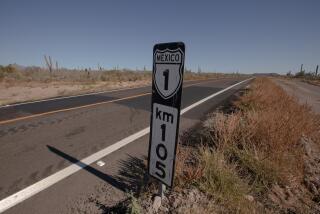Danger Ahead: Spotting Highway Hazards Abroad
- Share via
As an operator of an automobile in Southern California, you may think you know a thing or two about bad drivers, road rage, highway scams and auto theft. But if you’re planning to rent a car abroad--or maybe just cover a lot of miles by bus--you’d be wise to study a little more.
Road risks in Mexico, Europe and elsewhere can be much different from road risks here. In one recent survey, 19 countries reported higher traffic injury rates than the U.S.
This doesn’t necessarily mean that you shouldn’t rent a car or board a local bus in a foreign land: A car offers independence and flexibility, and local buses are not only affordable but also offer an opportunity to see a country beyond the finished veneer it presents to tourists. But wariness can be crucial.
In 1995, a Turkish bus crash killed 23 passengers, including an American medical student named Aron Sobel. His mother, fourth-grade teacher Rochelle Sobel of Potomac, Md., received the news in a telephone call from the U.S. State Department.
“After the State Department called,” she remembers, “I looked at the State Department’s consular information [about Turkey], and there was not a word of information about roads.” Yet other sources showed that Turkey’s roads are among the most dangerous in Europe.
So Sobel founded the nonprofit Assn. for Safe International Road Travel (ASIRT). Gleaning anecdotal reports and broader information from government releases, guidebooks and elsewhere, ASIRT, telephone (301) 983-5252, offers road safety data for 95 nations. For a donation ($5 or more is recommended), the group offers individual country reports. General information can be found on the group’s Internet site (https://www.asirt.org). An ASIRT membership costs $25 ($18 for students) and entitles you to five country reports yearly.
In its report on Turkey, the group’s list of recent major accidents mostly dated to 1997 but was nonetheless hair-raising: From Aug. 8 to Nov. 7, 1997, there were four bus-related accidents, with at least 125 combined fatalities. Two of the accidents were blamed on bus drivers falling asleep at the wheel.
The report’s more general information on road conditions and driver behavior included an International Road Federation finding that Turkey’s fatality rate per 100 million vehicle-kilometers (62 million vehicle-miles) in 1994 was 20.0, compared with 1.7 in the U.S.
Some nuggets from the association’s six-page Mexico report: That country’s fatality rate has been estimated at 25 per year per 10,000 vehicles, compared with less than three in the U.S. and less than 10 in most European countries. The report notes jarring speed bumps on main roads, wandering livestock (especially dangerous after dark) and ambiguous signals from some drivers on country roads (a blinker might mean the driver is turning left, or that the driver thinks it’s safe for you to pass on the left).
The report also names several roads that the association believes are among the most dangerous in Mexico. Most are highways connecting cities, although a sweeping reference warns (justifiably) that all Baja roads are risky in rain.
Sobel suggests travelers bear in mind that the greatest cause of death for healthy Americans abroad is road travel, a risk to pedestrians, passengers and drivers alike. Still, she adds, “We’re not telling anybody, ‘Don’t travel.’ We’re a family of travelers. We’re saying, ‘Know before you go.’ ”
A 1997 survey by the Economist magazine, drawing on data from the International Road Federation, found the world’s most dangerous driving was in the African nations of Malawi and Rwanda (2,730 and 1,764 injuries per 62 million vehicle-miles, respectively). Behind them came South Korea (725 injuries per 62 million vehicle-miles), Jordan, Costa Rica (406 injuries), Kenya, Turkey (329 injuries), Honduras, Portugal (234 injuries) and Egypt. Canada landed in 12th place (207 injuries), the U.S. in 20th (96 injuries). Mexico didn’t make the top 20. (Keep in mind that these lists depend on information provided by governments.)
The world’s most crowded road networks, according to the same survey, are in Hong Kong (289 vehicles per 0.62 mile of road), followed by Taiwan, Singapore, Kuwait, South Korea, Brunei, Israel, Thailand, Italy, Ukraine, Germany, Netherlands, Slovakia and (at 63 vehicles per 0.62 mile) Britain. Mexico ranked 23rd (46 vehicles per 0.62 mile), and the U.S. didn’t make the top 30.
Another good source of information for European road conditions is the Internet site of Moto Europa, a European motoring promotion group (https://www.ideamerge.com/ motoeuropa/), with facts on government regulations, filling stations, border requirements and many other details.
Despite Sobel’s 1995 experience, the State Department can be a useful source of information. The department offers free country updates by telephone and the Internet. Updates sometimes include advice on areas that may be risky for drivers (in past updates, the department has given details on Mexico in particular), but more often address crime, terrorism or civil strife. The State Department is at (202) 647-5225, Internet https://travel.state.gov/travel-warnings.html.
Two other organizations provide risk data by city or country: Kroll Information Services (city updates by fax, $19.95 each; tel. [800] 824-7502, Internet https://www .krollassociates.com/KTS/) and Pinkerton Global Intelligence Services (six maps yearly with country-by-country updates, at $6.95 per issue or $9.95 for a more detailed report; tel. [703] 525-6111, Internet https://www.pinkertons.com).
Reynolds travels anonymously at the newspaper’s expense, accepting no special discounts or subsidized trips. He welcomes comments and suggestions, but cannot respond individually to letters and calls. Write Travel Insider, Los Angeles Times, Times Mirror Square, Los Angeles 90053 or e-mail [email protected].
More to Read
Sign up for The Wild
We’ll help you find the best places to hike, bike and run, as well as the perfect silent spots for meditation and yoga.
You may occasionally receive promotional content from the Los Angeles Times.







